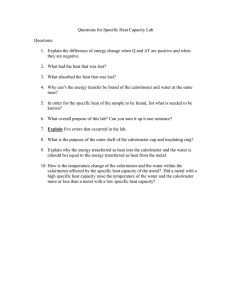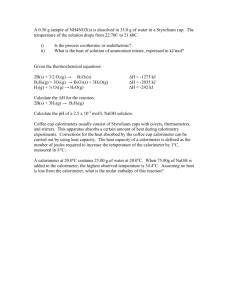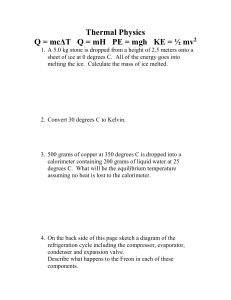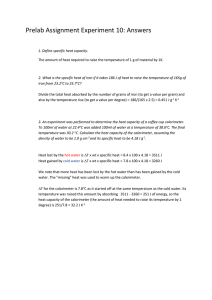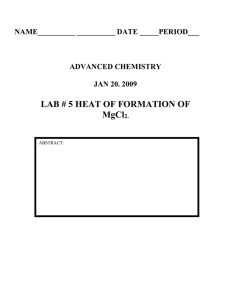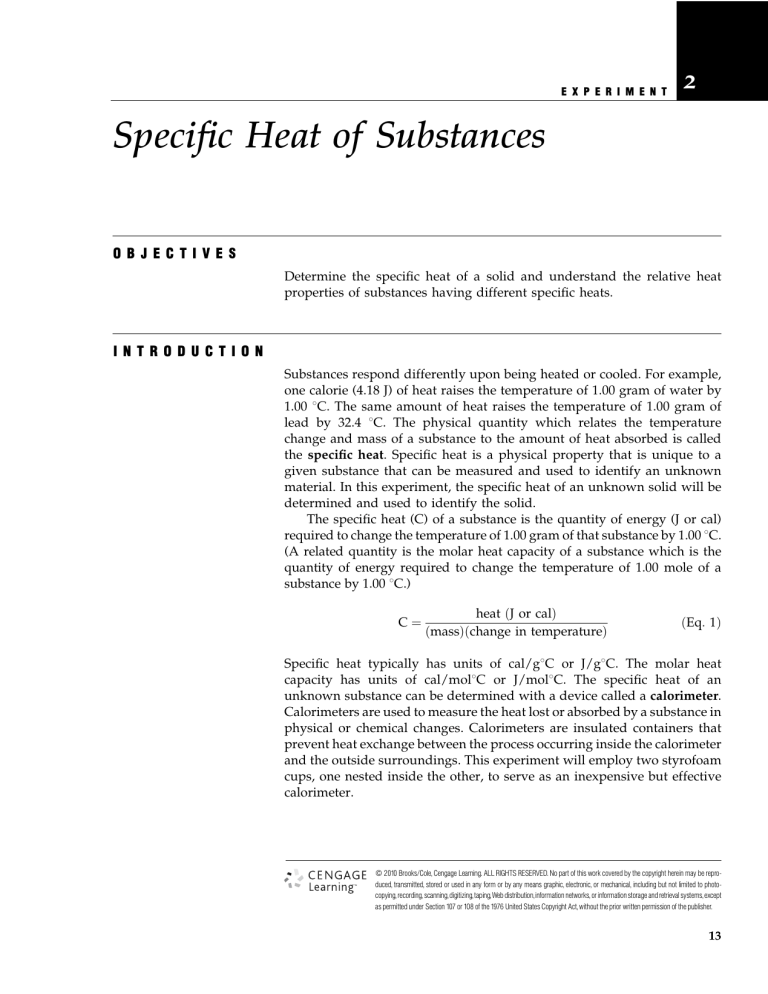
E XPERIMEN T 2 Specific Heat of Substances OBJECTIVES Determine the specific heat of a solid and understand the relative heat properties of substances having different specific heats. INTRODUCTION Substances respond differently upon being heated or cooled. For example, one calorie (4.18 J) of heat raises the temperature of 1.00 gram of water by 1.00 8C. The same amount of heat raises the temperature of 1.00 gram of lead by 32.4 8C. The physical quantity which relates the temperature change and mass of a substance to the amount of heat absorbed is called the specific heat. Specific heat is a physical property that is unique to a given substance that can be measured and used to identify an unknown material. In this experiment, the specific heat of an unknown solid will be determined and used to identify the solid. The specific heat (C) of a substance is the quantity of energy (J or cal) required to change the temperature of 1.00 gram of that substance by 1.00 8C. (A related quantity is the molar heat capacity of a substance which is the quantity of energy required to change the temperature of 1.00 mole of a substance by 1.00 8C.) C¼ heat ðJ or calÞ ðmassÞðchange in temperatureÞ ðEq: 1Þ Specific heat typically has units of cal/g8C or J/g8C. The molar heat capacity has units of cal/mol8C or J/mol8C. The specific heat of an unknown substance can be determined with a device called a calorimeter. Calorimeters are used to measure the heat lost or absorbed by a substance in physical or chemical changes. Calorimeters are insulated containers that prevent heat exchange between the process occurring inside the calorimeter and the outside surroundings. This experiment will employ two styrofoam cups, one nested inside the other, to serve as an inexpensive but effective calorimeter. ! 2010 Brooks/Cole, Cengage Learning. ALL RIGHTS RESERVED. No part of this work covered by the copyright herein may be reproduced, transmitted, stored or used in any form or by any means graphic, electronic, or mechanical, including but not limited to photocopying,recording,scanning,digitizing,taping,Web distribution,information networks,orinformation storage andretrievalsystems,except as permitted under Section 107 or 108 of the 1976 United States Copyright Act,without the prior written permission of the publisher. 13 14 Experiments in General Chemistry Featuring MeasureNet n Stanton et al. The First Law of Thermodynamics, or Law of Conservation of Energy, states that energy can neither be created nor destroyed during ordinary physical or chemical changes, but it can be transferred from one system to another. The Second Law of Thermodynamics implies that energy normally flows from substances at higher temperatures to substances at lower temperatures. Both laws will be used in this experiment to determine the specific heat of a substance. The heat (energy) lost or gained by a substance as its temperature changes can be calculated using the equation q ¼ m & C & DT ðEq: 2Þ where q is the heat change (units of J or cal) of the substance, m is the mass of the substance in grams, and DT is the change in temperature (in degrees 8C) of the substance (DT ¼ Tfinal % Tinitial). One way to determine the specific heat of a substance is to measure the heat lost by a given mass of a heated substance after it has been transferred into a known mass of water that is initially at room temperature. The aforementioned laws of thermodynamics indicate what will happen as the water and substance contact each other. The total amount of heat energy will be conserved and the cooler substance (water) will experience a temperature rise as the warmer substance cools. After a period of heat exchange, the equilibrium temperature, or final temperature, of the system will be attained. Given the specific heat of water (4.18 J/g8C), the mass of the water, and the changes in the temperature of the water and the substance; the heat absorbed by the water can be calculated. From the First Law of Thermodynamics, it is known that the heat absorbed by the water must be equal in magnitude to the heat lost by the substance. Mathematically this statement can be written as %q lost by substance ¼ q gained by water (The minus sign, preceding % q above, indicates that heat flows from the substance to the water). From Eq. 2, this can be rewritten as %ðmsubstance & Csubstance & DTsubstance Þ ¼ mwater & Cwater & DTwater ðEq: 3Þ Equation 3 can be rearranged to calculate the specific heat of the substance. Csubstance ¼ mwater & Cwater & DTwater %ðmsubstance & DTsubstance Þ ðEq: 4Þ If the heat exchanged in this experiment were solely limited to the metal and the water, Eq. 4 would be sufficient. However, heat will be lost to the surroundings (air, lab bench, etc.) near the mixture. Heat loss to the surroundings can be minimized by performing the experiment in a calorimeter that inhibits heat exchange with the surroundings. However, the calorimeter will also absorb some of the heat from the substance. The heat lost to the calorimeter must also be accounted for in this experiment. Therefore, it will be necessary to calibrate the calorimeter. The calorimeter constant (Ccal) is defined as the heat energy required to raise the Experiment 2 n Specific Heat of Substances 15 temperature of the calorimeter by 1.00 8C. The heat absorbed by the calorimeter, qcal, can be determined according to the equation qcalorimeter ¼ Ccalorimeter & DTwater or Ccalorimeter q ¼ calorimeter DTwater ðEq: 5Þ where Ccalorimeter is the calorimeter constant in J/8C, and DTwater is the change in the temperature of the water. If the heat absorbed by the calorimeter is included in Eq. 4, we can derive an accurate expression for the specific heat of a substance. heat lost by substance ¼ heat absorbed by water þ calorimeter %qsubstance ¼ qwater þ qcalorimeter %ðmsubstance & Csubstance & DTsubstance Þ ¼ ðmwater & Cwater & DTwater Þ þ ðCcalorimeter & DTwater Þ ðEq: 6Þ Equation 6 can be rearranged to yield the specific heat of the substance. Csubstance ¼ %½ðmwater & Cwater & DTwater Þ þ ðCcalorimeter & DTwater Þ* ðEq: 7Þ msubstance & DTsubstance The mass of the water and the substance are determined by difference (weigh an empty container; add water or substance to the container and reweigh, the difference in the two weights is the weight of water or substance). The specific heat of water is a well-established constant, 4.18 J/g8C. The challenging aspect of this experiment is to accurately determine temperature changes for the water, DTwater, and the substance, DTsubstance. Temperature changes will be monitored by recording temperature versus time scans (thermograms) using the MeasureNet temperature probe. Figure 1 depicts a thermogram used to determine the calorimeter constant of a styrofoam cup calorimeter. NOTE: When determining DTwater or DTsubstance, subtract the initial temperature of the water or substance, Ti, from the final temperature of the solution, Tf. 34.8 °C 38 o Temperature, C ! 2010 Brooks/Cole, Cengage Learning Calibration of Styrofoam Cup Calorimeter Figure 1 Thermogram for the addition of 31.152 grams of water at 51.0 8C to 31.284 grams of water at 20.2 8C. The equilibrium temperature of the system is 34.8 8C. 33 28 ∆T 20.2 °C 23 18 0 5 10 15 20 Time, s 25 30 35 16 Experiments in General Chemistry Featuring MeasureNet n Stanton et al. SAMPLE CALCULATIONS Determination of the Calorimeter Constant In this example, a known amount of warm water is mixed with a known amount of cool water. The hot water loses heat to the cool water until an intermediate, equilibrium temperature is attained. The heat absorbed by the calorimeter is the difference in the heat lost by the warm water and the heat absorbed by the cool water. If 31.152 mL of water (31.152 g assuming the density of water is 1.00 g/mL at ambient temperatures) at 51.0 8C are mixed with 31.284 mL (31.284 g) of water in a calorimeter at 20.2 8C, the equilibrium temperature attained by the system is 34.8 8C (Figure 1). The specific heat of water is 4.18 J/g8C. Calculate the calorimeter constant for this system in J/8C. %qwarm water ¼ qcool water þ qcalorimeter qcalorimeter ¼ %qwarm water % qcool water qcalorimeter ¼ %ðmwarm water & Cwarm water & DTwarm water Þ % ðmcool water & Ccool water & DTcool water Þ ! " ! " 4:18 J 4:18 J & ð34:8 % 51:0 8CÞ % 31:284 g & & ð34:8 % 20:2 8CÞ qcalorimeter ¼ % 31:152 g & g8C g8C qcalorimeter ¼ 2110 J % 1910 J qcalorimeter ¼ 200: J Ccalorimeter ¼ qcalorimeter DTcool water Ccalorimeter ¼ 200: J ¼ 13:7 J=8C ð34:8 8C % 20:2 8CÞ The calorimeter constant for the styrofoam calorimeter indicates that the calorimeter absorbs 13.7 J of heat for every 1.00 8C change in the temperature of the system. The value of the calorimeter constant will be used in the following sample calculation to determine the specific heat of an unknown substance. When calculating Ccalorimeter, always use DTcool water because the calorimeter is initially at the same temperature as the cool water and both absorb energy from the warm substance. Determination of the Specific Heat of a Solid 7.050 grams of an unknown solid is heated to 100.0 8C. The warm solid is added to a calorimeter containing 50.00 grams of water at 24.00 8C. The system attains an equilibrium temperature of 24.90 8C. Use this information and Eq. 7 to determine the specific heat of the solid. Csolid ¼ Csolid ¼ %½ðmwater & Cwater & DTwater Þ þ ðCcalorimeter & DTwater Þ* msolid & DTsolid %½ð50:00 gÞ ð4:18 J=g8CÞ ð24:90 % 24:00 8CÞ þ ð13:7 J=8CÞ & ð24:90 % 24:00 8CÞ* 7:050 g & ð24:90 % 100:08CÞ Csolid ¼ %½190 J þ 12 J* ¼ 0:38 J=g8C %529 g8C Experiment 2 n Specific Heat of Substances 17 Table 1 Specific heat values for selected substances Solids Aluminum 0.897 J/g8C Calcium Carbonate 0.837 J/g8C Copper 0.385 J/g8C Copper(II) Oxide 0.533 J/g8C Graphite, C(s) 0.709 J/g8C Iron 0.450 J/g8C Lead 0.129 J/g8C Zinc 0.389 J/g8C Liquids 1,5-Pentanediol 3.08 J/g8C 1-Hexene 2.18 J/g8C 1-Propanol 2.40 J/g8C Acetone 2.17 J/g8C Ethanol 2.45 J/g8C Glycerol 2.38 J/g8C Water 4.18 J/g8C Table 1 lists the specific heat values of several solids and liquids. From the data presented in Table 1, the solid could be either copper or zinc metal. From Table 1, it is evident that solids generally have lower specific heat values than liquids. In particular, water has a very high specific heat even compared to the other liquids in the table. That is one reason why water is commonly chosen as a coolant for automobile engines. PROCEDURE ! 2010 Brooks/Cole, Cengage Learning CAUTION Students must wear departmentally approved eye protection while performing this experiment. Wash your hands before touching your eyes and after completing the experiment. Part A - Determination of the Calorimeter Constant 1. See Appendix A-1 – Instructions for Initializing the MeasureNet Workstation to Record a Temperature versus Time Scan. Complete all steps in Appendix A-1 before proceeding to Step 2 below. 2. See Appendix A-2 – Instructions for Recording a Temperature versus Time Thermogram to Determine the Styrofoam Cup Calorimeter Constant. Complete all steps in Appendix A-2 before proceeding to Step 3. 18 Experiments in General Chemistry Featuring MeasureNet n Stanton et al. 3. Steps 4–6 are to be completed after the laboratory period is concluded (outside of lab). Proceed to Step 8, Determining the Specific Heat of a Solid 4. From the tab delimited files you saved, prepare plots of the temperature versus time data using Excel (or a comparable spreadsheet program). Instructions for plotting temperature versus time thermograms using Excel are provided in Appendix B-1. 5. How do you determine the equilibrium temperature of the hot-cold water mixture in the calorimeter? How do you determine the temperature changes for the warm water and the cold water? Should these temperatures be recorded in the Lab Report and to how many significant figures? 6. What calculations are required to determine the calorimeter constant in J/8C? From the results of Trials 1 and 2, determine the average calorimeter constant. 7. Use the same two styrofoam cups in Part B of the experiment that were used in Part A. The calorimeter constant determined in Part A will be used in Part B of this experiment to determine the specific heat of the unknown solid. Part B - Determination of the Specific Heat of a Solid 8. 45–50 grams of tap water should be added to the calorimeter to serve as the cool water. Should the exact mass of the cool water be recorded in the Lab Report? If so, to what number of significant figures should the mass be recorded? 9. Place a stir bar in the bottom of the calorimeter and turn the power on to a low to medium setting. Be sure the stir bar does not contact the temperature probe or the walls of the container when spinning. 10. Obtain an unknown solid and record the Unknown Number in the Lab Report. Bobby Stanton/Wadsworth/Cengage Learning 11. 15 to 20 grams of the unknown solid must be added to a 25 & 200 mm test tube (a large test tube), and nested inside of a 250 mL beaker. Must the exact mass of the unknown solid be determined? Should the mass be recorded in the Lab Report, and to how many significant figures? Figure 2 Heating solid inside a test tube immersed in boiling water 12. Place the beaker containing the test tube with solid on a hot plate, and add ' 125 mL of water to the beaker (Figure 2). Bring the water to a gentle boil. Do not allow any water to splash into the test tube containing the solid. Secure the test tube to a ring stand with a utility clamp. 13. Insert a thermometer into the solid (inside the test tube, see Figure 2). The thermometer must not touch the bottom or the walls of the test tube (tip of thermometer should be at least 1 cm from the bottom of the test tube). The test tube containing the unknown metal should remain in boiling water for 10 minutes. 14. Note the temperature on the MeasureNet workstation display. How should the temperature of the cool water be determined? Should this temperature be recorded in the Lab Report and to what number of significant figures? 15. Leave the test tube containing unknown solid in the boiling water for at least 10 minutes. How should the temperature of the solid be determined? Should this temperature be recorded in the Lab Report, and to what number of significant figures? Experiment 2 n Specific Heat of Substances 19 16. Press Start on the MeasureNet workstation to start the scan. After 5–10 seconds have elapsed, raise the calorimeter lid. Remove the thermometer from the test tube containing the hot solid. Using the utility clamp to hold the hot test tube, quickly, but carefully, transfer all of the hot solid from the test tube to the calorimeter. Do not splash water from the calorimeter as the solid sample is added. Immediately replace the lid on the calorimeter. 17. Be sure the stir bar is still turning. If a stir bar is not available, stir the contents of the calorimeter with the wire stirrer. Be sure the probe stays submerged in the water at all times. Do not slosh any water out of the calorimeter. 18. Once the water temperature has risen and stabilized at a constant temperature (reaching equilibrium), press Stop to end the scan. 19. Press File Options, then press F3 to save the scan. Enter a 3 digit code when prompted, then press Enter. Save the file to a disk, flash drive, or email the files to yourself via the internet. 20. Record the file name in your Lab Report. Note what type of information is contained in the file in the Lab Report. 21. Press Display to clear the previous scan. You are now ready to press Start to record a subsequent scan for a new experimental trial. 22. Remove the stir bar from the calorimeter with a magnetic rod. Decant the water in the calorimeter into a beaker. Remove any pieces of metal from the beaker, and pour the water into the sink. 23. Thoroughly dry the unknown solid with a towel. Pour the solid into the ‘‘Used Unknown Solid’’ container bearing the same number as your unknown. Thoroughly dry the calorimeter. 24. Perform a second trial to determine the specific heat of the unknown solid by repeating Steps 8–23. 25. When you are finished with the experiment, transfer the files to a flash drive, or email the files to yourself via the internet. 26. Return the dry styrofoam cups and lid to your instructor. ! 2010 Brooks/Cole, Cengage Learning 27. From the tab delimited files you saved, prepare plots of the temperature versus time data using Excel (or a comparable spreadsheet program). Instructions for plotting temperature versus time thermograms using Excel are provided in Appendix B-1. 28. How do you determine the equilibrium temperature of the hot solidcold water mixture in the calorimeter? How do you determine the temperature changes for the hot solid and the cold water? Should these temperatures be recorded in the Lab Report and to how many significant figures? 29. What calculations are required to determine the specific heat of the unknown solid? From the results of Trials 1 and 2, determine the average specific heat of the unknown solid. 30. Using the information provided in Table 1, identify the unknown solid. This page intentionally left blank Name . . . . . . . . . . . . . . . . . . . . . . . . . . . . . . . . . . . . . . . . . . . . . . . . . . . . . . . . . . . . . . . . . . . . . Section . . . . . . . . . . . . . . . Date . . . . . . . . . . . . . . . Instructor . . . . . . . . . . . . . . . . . . . . . . . . . . . . . . . . . . . . . . . . . . . . . . . . . . . . . . . . . . . . . . . . . . 2 E X P E R I M E N T 2 Lab Report Submit all thermograms along with your lab report. Part A – Determination of the Calorimeter Constant Experimental data and calculations – Trial 1 ! 2010 Brooks/Cole, Cengage Learning Experimental data and calculations – Trial 2 21 22 Experiments in General Chemistry Featuring MeasureNet n Stanton et al. Average calorimeter constant __________ J/8C Part B – Determination of the Specific Heat of a Solid Unknown number __________ Experimental data and calculations – Trial 1 Experiment 2 n Specific Heat of Substances Experimental data and calculations – Trial 2 Average specific heat of the solid __________ J/g8C Using the specific heat values given in Table 1, identify the unknown solid. ! 2010 Brooks/Cole, Cengage Learning ___________________________________ 23 This page intentionally left blank


